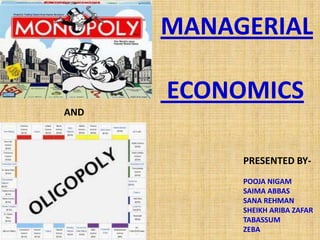
Monoploy
- 1. MANAGERIAL ECONOMICS AND PRESENTED BYPOOJA NIGAM SAIMA ABBAS SANA REHMAN SHEIKH ARIBA ZAFAR TABASSUM ZEBA
- 2. Monopoly • Origins of monopoly: – Through growth of the firm – Through amalgamation, merger or takeover – Through acquiring patent or license – Through legal means – Royal charter, nationalisation, wholly owned plc
- 6. DEFINITION OF MONOPOLY 1) According to PROF. CHAMBERLAIN,” Monopoly refers to the control over supply.” PROF. CHAMBERLAIN PROF.ROBERT TRIFFIN 2) According to PROF.ROBERT TRIFFIN ,”Monopoly is a market situation in which the firm is independent of price changes in the product of each and every other firm.”
- 10. EXISTENCE OF MONOPOLY •True monopolies generally existing government controlled markets. . EXAMPLE- INDIAN RAILWAY •Monopoly in private businessisrare. •Private firms who have considerable marketshare. . EXAMPLE- MICROSOFT,INTEL,GOOGLE.
- 12. Monopoly power
- 18. Monopoly Costs / Revenue MC £7.00 AC Monopoly Profit AR (D) curve for a monopolist likely to be relatively price inelastic. Output assumed to be at profit maximising output (note caution here – not all monopolists may aim for profit maximisation!) This is both the short run and long run equilibrium position for a monopoly £3.00 Given the barriers to entry, the monopolist will be able to exploit abnormal profits in the long run as entry to the market is restricted. MR Q1 AR Output / Sales
- 19. The higher price and lower output means that consumer surplus is reduced, indicated by the grey shaded area. Monopoly Welfare implications of monopolies Costs / Revenue MC £7 AC Loss of consumer surplus A look back at competitive for The price in a the diagram The monopoly price perfect competition will reveal market would be £3 with that in equilibrium,per will be would be at Q1.priceunit output levels £7 equal to the MC of production. with output levels We can lookQ2. lower at therefore at a comparison of the differences between face of it, On theprice and output in a competitive situation compared consumers face to a monopoly. £3 AR MR Q2 Q1 higher prices and less choice in monopoly conditions compared to more competitive environments. Output / Sales
- 20. Monopoly Welfare implications of monopolies Costs / Revenue MC £7 AC Gain in producer surplus £3 The monopolist will benefit from additional producer surplus equal to the grey shaded rectangle. AR MR Q2 The monopolist will be affected by a loss of producer surplus shown by the grey triangle but…….. Q1 Output / Sales
- 21. TYPES OF MONOPOLY • Monopoly: • Pure monopoly – industry is the firm! • Actual monopoly – where firm has >25% market share. • Natural Monopoly – high fixed costs – gas, electricity, water, telecommunications, rail. TELECOMMUNICATI ON RAIL
- 22. ADVANTAGES OF MONOPOLY Advantages: 1) May be appropriate if natural monopoly Encourages R&D. 2) Encourages innovation. 3) Development of some products not likely without some guarantee of monopoly in production. 4) Economies of scale can be gained – consumer may benefit.
- 23. DISADVANTAGES OF MONOPOLY • Disadvantages: – Exploitation of consumer – higher prices. – Potential for supply to be limited - less choice. – Potential for inefficiency – X-inefficiency – complacency controls on costs. over
Notes de l'éditeur
- v